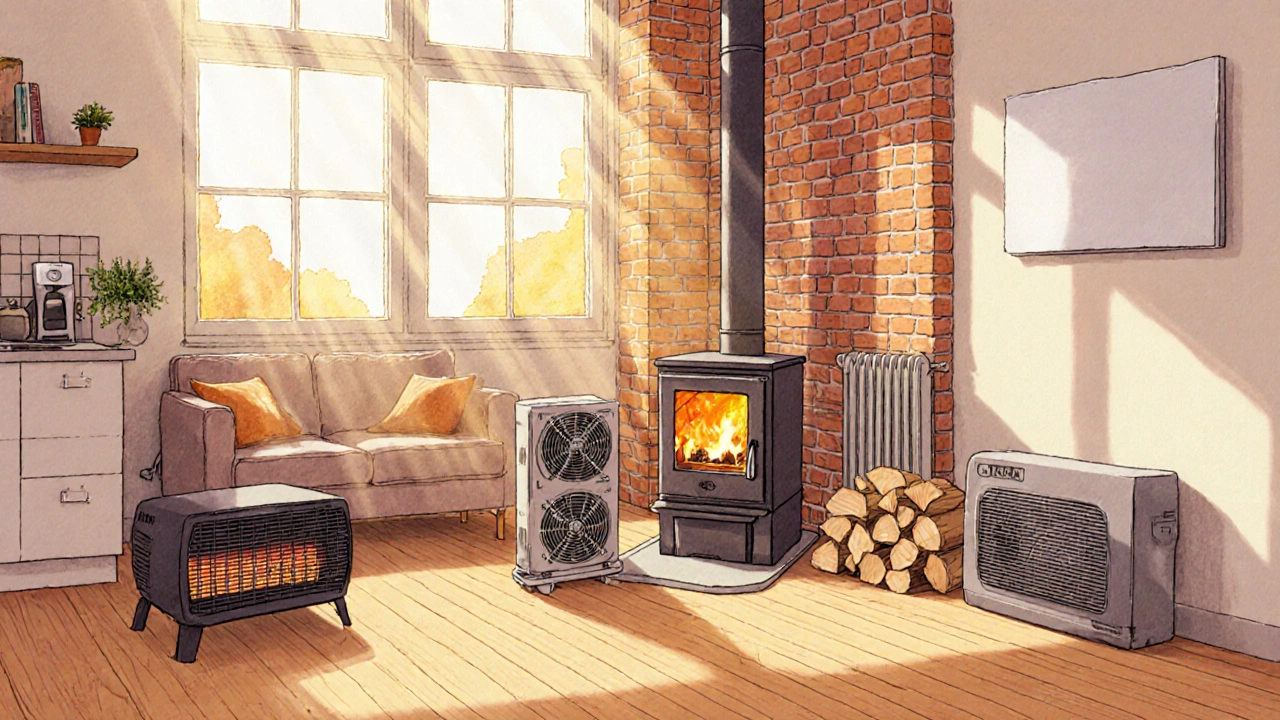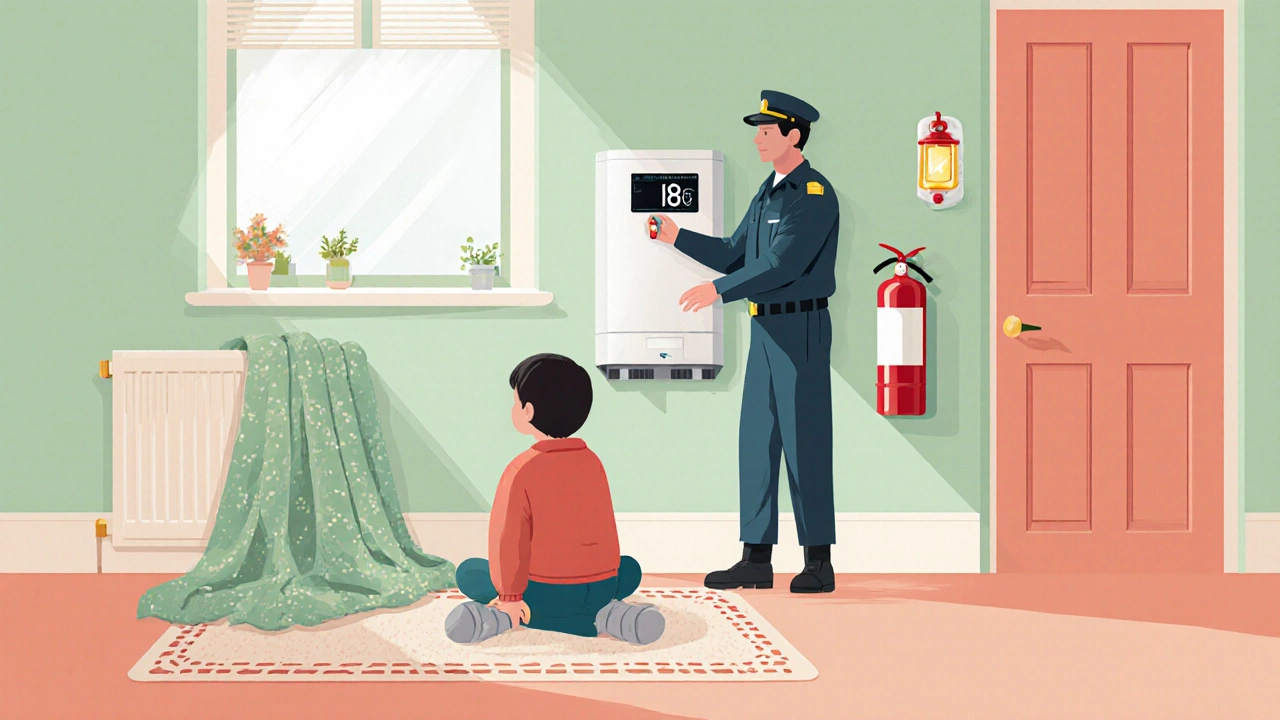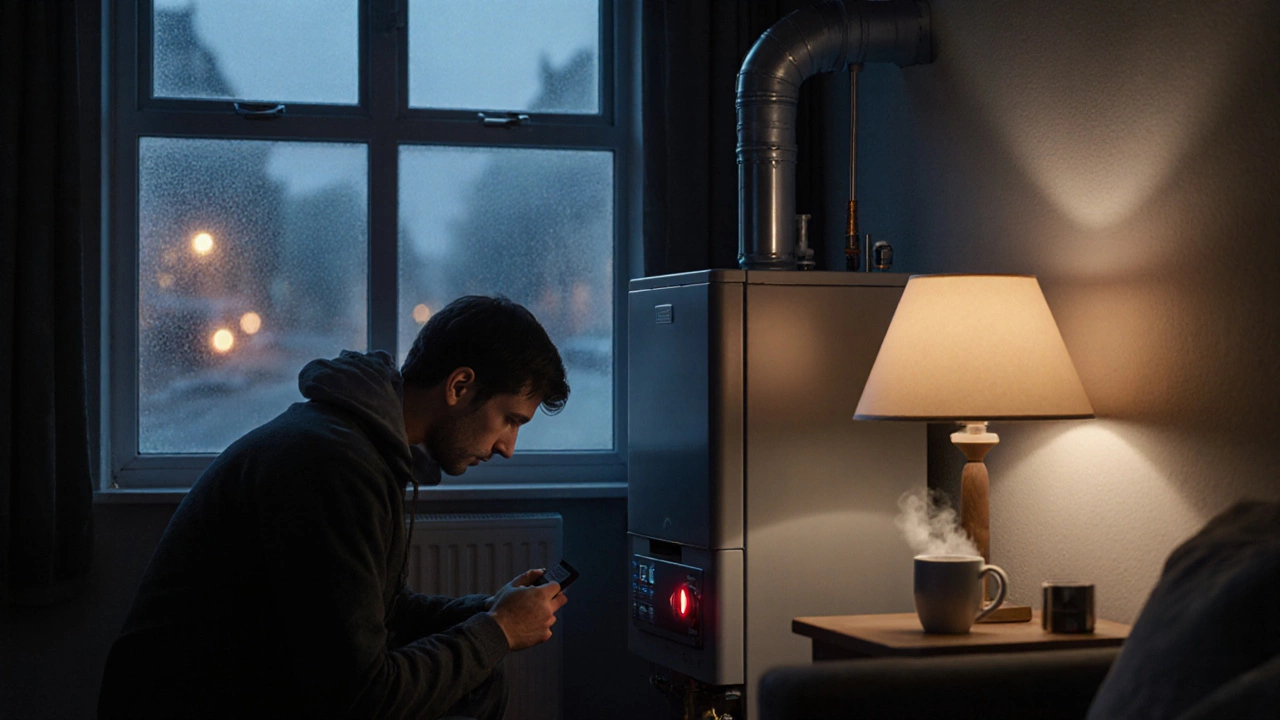Boiler Backup Heating Calculator
Calculate Your Backup Heating Needs
Recommended Heating Solution
Heating Method Comparison
| Method | Power Source | Output (kW) | Cost (NZD) | Safety Rating |
|---|---|---|---|---|
| Electric Space Heater | Electricity | 1-2 | 30-150 | High |
| Air-Source Heat Pump | Electricity | 3-7 | 500-1500 | High |
| Wood-Burning Stove | Wood logs | 5-10 | 800-2000 | Medium |
When the boiler quits on a chilly evening, panic can set in fast. Heating a house with a broken boiler means finding safe, quick ways to keep every room comfortable until the system is fixed. You don’t have to freeze or resort to pricey hotel rooms - a few practical steps and the right backup devices can hold the temperature steady and buy you time.
Understand the problem before you panic
First, confirm the boiler really is out. Look for common signs: no hot water, cold radiators, strange noises, or an error code on the display. If you hear a clicking sound or see a leak, shut the gas or electric supply immediately - safety comes first.
Once you know the boiler is non‑functional, the next question is how long the repair will take. A simple reset may bring it back in minutes; a major component failure could keep you waiting days. Your emergency plan should cover both short‑term (hours) and medium‑term (days) scenarios.
Immediate safety checks
- Turn off the gas valve if you smell gas or see a leak.
- Switch off the main electricity switch for electric boilers to avoid electrical hazards.
- Ventilate the area for at least 15 minutes if you suspect a gas leak.
These steps protect you and your family while you arrange a backup heating method.
Quick fixes that could get the boiler running again
Before you invest in alternatives, try these low‑effort fixes:
- Reset the boiler using the reset button (usually a small red or black button on the control panel).
- Check the pressure gauge; most boilers need 1-1.5 bar when cold. If it’s low, add water via the filling loop.
- Bleed any air‑locked radiators by opening the bleed valve with a key until water flows steadily.
- Inspect the thermostat settings - sometimes the thermostat is set too low or in “away” mode.
If these steps don’t revive the system, move on to temporary heating options.

Short‑term heating alternatives
Below are the most common backup solutions, each introduced with microdata for quick reference.
Electric space heater is a plug‑in device that converts electricity into radiant or convective heat, ideal for single rooms. Look for models with built‑in thermostats and tip‑over protection.
Wood‑burning stove uses solid fuel to generate high amounts of heat and can warm an entire floor plan if properly sized. Ensure the chimney is clean and the stove complies with local fire regulations.
Portable gas heater runs on LPG or natural gas and provides rapid heat for medium‑sized areas; it must be used in well‑ventilated spaces.
Air‑source heat pump extracts heat from outside air and circulates it indoors, offering efficient heating even at 0°C. Portable units can be plugged into a standard outlet and moved between rooms.
Radiant panel heater mounts on walls or ceilings and emits infrared heat directly to objects and people, reducing heat loss through windows.
Thermal blanket is a reflective foil covering placed under curtains or over windows to keep heat inside. It’s cheap and easy to install.
Insulation upgrades include sealing drafts, adding door sweeps, and applying window film to reduce heat escape. While not a heat source, better insulation maximises whatever heat you generate.
Choosing the right backup: a quick comparison
| Method | Power source | Typical output (kW) | Cost (NZD) | Safety rating* |
|---|---|---|---|---|
| Electric space heater | Electricity | 1-2 | 30‑150 | High (auto‑shutdown) |
| Wood‑burning stove | Wood logs | 5-10 | 800‑2000 (including installation) | Medium (requires ventilation) |
| Portable gas heater | LPG / Natural gas | 2-5 | 120‑300 | Medium (must vent) |
| Air‑source heat pump | Electricity | 3-7 | 500‑1500 (portable) | High (no combustion) |
| Radiant panel heater | Electricity | 0.5-1.5 | 100‑400 | High (no moving parts) |
*Safety rating reflects built‑in protection features, need for ventilation, and fire risk.
Practical tips to maximise any temporary heat source
- Close doors to rooms you’re not heating - this traps warm air where you need it.
- Use a programmable thermostat (or a simple plug‑in timer) to avoid running heaters all night.
- Place heaters away from curtains, blankets, and children’s play areas.
- Combine two low‑output methods (e.g., electric heater + radiant panels) for even distribution.
- Lay rugs on cold floors; they act as insulators and feel cozier.

When to call a professional
If the boiler shows any of the following, stop DIY attempts and book a qualified technician:
- Persistent error codes after a reset. \n
- Visible cracks or corrosion on the heat exchanger.
- Repeated loss of pressure despite refilling.
- Unusual smells (gas, burning plastic) that don’t dissipate.
Professional repairs in NewZealand typically cost between NZD200and600, depending on part availability. A quick estimate can be obtained by calling local boiler services in Dunedin or surrounding Otago region.
Emergency heating checklist
- Verify boiler is truly offline and perform basic safety shut‑offs.
- Try a reset, pressure check, and radiator bleed.
- Pick the most suitable temporary heater based on room size, fuel availability, and safety.
- Set up the heater following manufacturer instructions; keep a fire extinguisher nearby.
- Seal drafts - use door sweeps, window film, and thermal blankets.
- Contact a licensed boiler technician; schedule a repair within 48hours.
- Monitor indoor temperature; aim for at least 18°C for comfort and health.
Frequently Asked Questions
Can I leave an electric space heater on overnight?
Only if the unit has an automatic shut‑off timer or thermostat. Continuous operation can overload circuits and increase fire risk. It’s safer to set a timer or use a smart plug that turns the heater off after a few hours.
Is a portable gas heater safe for a small apartment?
It can be, but only with proper ventilation - open a window slightly and never use it in an enclosed bedroom. Choose a model with an oxygen depletion sensor (ODS) and keep a carbon monoxide detector nearby.
Do heat pumps work when it’s freezing outside?
Modern air‑source heat pumps maintain efficiency down to about‑5°C and still provide some heating at‑15°C, though output drops. In NewZealand’s milder winters, a portable heat pump is a reliable backup.
How long can I rely on a wood‑burning stove?
As long as you have dry wood and the chimney is clear. Remember to clean ash regularly and schedule an annual chimney sweep to prevent creosote buildup.
What’s the cheapest way to keep heat in a broken‑boiler home?
Start with insulation: seal drafts, use thermal blankets, and lay rugs. Then add a low‑wattage electric heater in the rooms you occupy most. The combined cost stays under NZD200.
